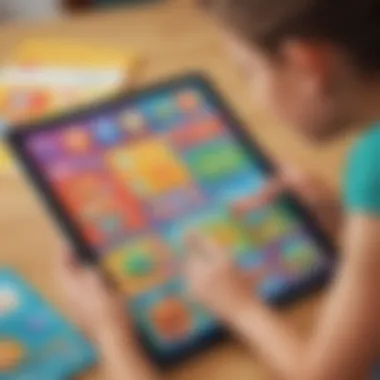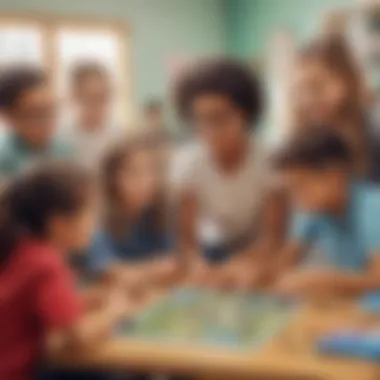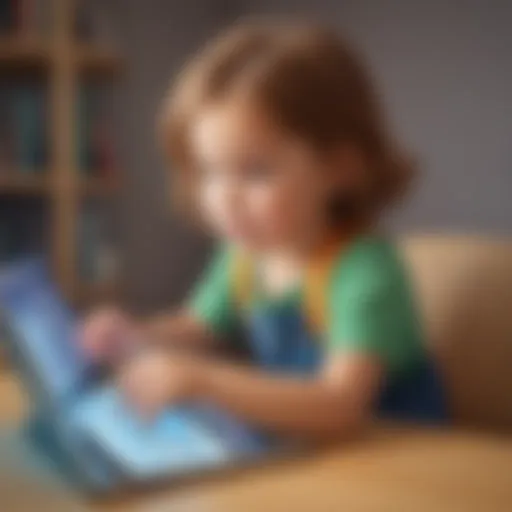Top Educational Apps for Engaging 6 Year Olds


Intro
In the digital age, educational apps have become a central element in the learning landscape for young children. By leveraging technology, parents and educators can introduce six-year-olds to engaging and effective learning experiences. This article delves deeply into the best educational apps available for this age group, focusing specifically on creative stimulation, interactive quizzes, and insightful fact-based content.
As parents and caregivers select apps, understanding each app's educational value and purpose is essential. The resources provided can foster skills in literacy, numeracy, and critical thinking. Many apps cater to multiple developmental needs, offering rich opportunities for growth.
Creative Activities
Creative activities are vital for six-year-olds as they keep their minds engaged and stimulate their imagination. Different educational apps provide various activities that encourage creativity.
- Craft Ideas: Popular apps like Toca Nature and DIY.org inspire children to engage in various craft projects that are simple yet enjoyable. Through these, children can practice skills like cutting, Coloring, and even following instructions to make creative crafts.
- Step-by-Step Guides: Many apps provide clear, concise instructions to guide children through each activity. For instance, Let's Create! Pottery offers children step-by-step guides to create virtual pots, which remains interactive through user engagement.
- Educational Value: Beyond fun, such activities also promote essential cognitive skills. Engaging in creative crafts helps with fine motor skills, enhances problem-solving abilities, and nurtures emotional expression. Crafting in a digital environment can bolster children's understanding of basic design concepts.
Fun Quizzes
Quizzes can serve as effective tools for reinforcing knowledge while keeping children interested in learning.
- Quiz Topics: Apps like Quizizz and Kahoot offer a variety of topics that resonate well with six-year-olds, including animals, history, and basic mathematics.
- Question Types: Ensuring children remain engaged is critical. A range of question types, including multiple-choice and true/false, supports diverse preferences and learning styles. Incorporating visual aids within quizzes can also enhance understanding.
- Knowledge Reinforcement: These quizzes aid memory retention and recall. They engage children dynamically, providing instant feedback, thus supporting learning outcomes and making education enjoyable, not tedious.
Learning through play within quiz formats grows better learners while allowing fun.
Fact-Based Articles
Fact-based articles within educational apps are another way to bring knowledge to children in captivating formats.
- Topics: Covered topics can range widely, from nature and science to cultural stories. Kids’ exploration apps, like National Geographic Kids, provide a diverse range of engaging content that piques curiosity.
- Engaging Content: The articles cater specifically to young readers through pictures and simple language. This helps in grasping complex concepts with ease, making learning less intimidating and straightforward.
- Additional Resources: Beyond individual articles, many apps offer related resources, helping further exploration on evidence-based subjects. For those interested, links to detailed information can be found at Britannica Kids and Wikipedia.
Prelims to Educational Apps
Educational apps are an increasingly influential tool in the learning landscape. These applications provide interactive and engaging methods to teach children skills required in a digital age. For six-year-olds, the experience can redefine learning.
The importance of educational apps extends beyond simple gameplay. They are designed to enhance creativity, foster problem-solving, and improve critical thinking. Recognizing that young minds thrive through exploration, these apps encourage children to delve into subjects like math, reading, science, and the arts.
Moreover, educational apps serve to personalize learning. Each child is unique, with varying interests and learning paces. Apps allow for tailored educational experiences that can accommodate individual needs. Parents and caregivers often appreciate this versatility, knowing that their child is learning through methods that resonate best with them.
However, navigating the vast world of educational apps requires careful consideration. With thousands of options available, understanding what to prioritize in selecting these applications is crucial. Features like age-appropriateness, educational value, and user experience are significant. The intended goal is not merely providing entertainment but also ensuring that the chosen apps create substantial learning opportunities.
It is essential to monitor children's app usage. More than just screen time, educators and parents should focus on quality interactions. Encouraging discussions about app content serves as a way to evaluate understanding and gauge interest.
"The right educational apps can make learning a sheer joy for young minds."
In summary, educational apps are useful tools for six-year-olds. They not only complement traditional learning but extend it into the digital realm in exciting ways. Striking a balance between play and education allows children to thrive, setting a strong foundation for lifelong learning.
Importance of Educational Apps for Young Learners
As digital technology becomes increasingly integrated into daily life, educational apps emerge as essential tools for children. Notably for 6-year-olds, these apps offer several significant advantages that inform their development. They not only entertain but also educate, proving to be effective tools in the essential early years of learning.
First and foremost, educational apps present content in engaging formats. This inspires curiosity while making learning enjoyable. Instilling knowledge through interactive and visually appealing mediums can enhance retention. Children are more likely to absorb information and skills when they associate learning with play.
Another critical aspect is the ability to customize learning experiences. Many types of apps cater to different skill levels. This allows parents and educators to tailor learning to individual child’s pace and preferences. For instance, a child who excels in reading might need apps that focus less on basic phonics and more on comprehension instead.
Moreover, the importance of immediate feedback in the learning process cannot be understated. Educational apps typically range from simple quizzes with direct answers to more complex problem-solving tasks. Instant assessment enables children to understand concepts better, correcting mistakes without the fear of judgment. Thus, this fosteres confidence and a willingness to try again if unsuccessful.
"Apps transform boring academic subjects into interactive experiences, providing an ecosystem where learning interfaces smoothly with play."
Additionally, social skills development is supported through some apps, encouraging teamwork and communication. This is essential as children engage with peers, whether in shared learning environments or multiplayer functionalities. By working on projects or solving problems collectively, they enhance critical life skills.
Devices linked to educational apps also serve as convenient platforms for parents and educators. They can easily monitor progress and adapt materials accordingly. This engagement helps in achieving learning goals while remaining connected to the child's educational journey.
Criteria for Selecting Educational Apps
Selecting the right educational apps for six-year-olds is a significant consideration. At this age, children's cognitive, social, and emotional development is rapid and essential as they start formal schooling. Thus, the features of educational apps should support diverse aspects of their growth. Parents and educators need to interrogate what makes an app beneficial and worth their time and attention.
Age-Appropriateness
Age-appropriateness refers to the alignment of app content and activities with the developmental stage of a child. An app should be designed considering the specific emotional and cognitive needs of a six-year-old. If content is too simple, it can become boring. On the other hand, if it is overly complex, it can lead to frustration.
Well-chosen apps aiming at six-year-olds should present content in an engaging way, combining playful learning with challenges suited to their skill level. Parents should scrutinize the recommended age by the developers as well as reviews that praise the app’s suitability for this age group.
Engagement Factor


Engagement is crucial for maintaining a child's interest. An app that captivates a child can offer extended interaction and learning opportunities. Features such as vibrant graphics, intuitive navigation, and interactive elements drive engagement.
You should observe how immersive an app is before deciding on its regular use. Activities should be hands-on, allowing for exploration and interaction. Feedback from the app, such as rewards or recognition for tasks completed, can also inject much-needed motivation for children to keep searching deeper and continuing their learning journey.
Educational Value
An app's educational value determines how effectively it fosters learning. Educational activities must align with objective standards, be it literacy, numeracy, or general knowledge. Parents should look for apps that not only have entertainment value but also support academic skills.
Review descriptions and objectives the app sets out. Includes aspects like vocabulary building, essential math skills, or aspects of nature exploration. Practical applications substantiate a strong educational base, ultimately helping gird a young person's foundational knowledge.
User Experience and Interface
User experience plays a vital role in how children interact with technology. An app tailored for a six-year-old should exhibit a simple and colorful interface that guides users confidently through the content. Complexity in design only adds friction, leading to less productive experiences.
Touch mechanisms should be sensitive, and buttons should be appropriately sized. Inclusivity in design, such as audio cues or diverse characters, increases relatability making users feel more engaged.
Safety and Privacy Concerns
Safety is a non-negotiable aspect for parents. With online interactions, there are permanent risks. Many apps collect user data, so it’s wise to scrutinize privacy policies. Applications should ideally follow strict guidelines for data protection. Look for keywords such as “no ads”, “no tracking”, or similar features that emphasize commitment to user privacy.
Engagement with forums or groups discussing educational tech can yield insights into the safest app choices available, helping to create a positive learning experience for every child.
Understanding and focusing on these criteria can bridge the gap between engagement and true education. By choosing thoughtfully, parents influence learning experiences favorably.
Types of Educational Apps
Educational apps can be classified into several categories, and each serves a distinct purpose in the learning journey of a child. Understanding the types of educational apps available offers insight into how they can facilitate growth and knowledge acquisition. Each category ties closely to the developmental areas that are crucial for six-year-old learners to master. This structured approach allows parents and educators to select the most suitable resources based on individual needs.
The key types of educational apps include:
- Math Apps: Designed to nurture mathematical skills through interactive puzzles and problems.
- Reading and Literacy Apps: Focus on phonics, vocabulary, and comprehension, contributing vastly to a child’s linguistic development.
- Science and Exploration Apps: Encourage curiosity about the world, prompting young minds to delve into scientific inquiry.
- Creative Arts Apps: Offer children the opportunity to express themselves creatively through art and music.
- Coding and Logical Thinking Apps: Lay the groundwork for problem-solving skills and logical reasoning crucial for future academic endeavors.
These app types cater to various aspects of development, such as critical thinking and creativity, enabling balanced growth. By choosing the right apps, caregivers can build a learning environment that is not only enriching but also enjoyable.
Math Apps
Math apps are vital for building solid foundational skills. They cover diverse areas such as number recognition, basic addition and subtraction, and even introductory fractions. It is essential for learning to occur in a fun and engaging way. Math games often incorporate rewards and levels, motivating children to continue improving.
Additional benefits include:
- Development of problem-solving skills.
- Encouragement of logical reasoning through math-related puzzles.
- Promotion of a positive attitude towards mathematics.
Examples of effective math apps include Matific and Endless Numbers, both building skills while embedding engagement deeply.
Reading and Literacy Apps
The logarithmic growth of language during a child’s early years is significant, making reading apps crucial. They promote phonics and vocabulary, essential for early literacy. Engaging stories enhance comprehension, and features such as read-aloud help facilitate better pronunciation and understanding.
While investigating options, consider that:
- Storytelling elements can encourage imagination.
- Interactive features keep them focused and attentive.
Starfall and ABCmouse.com are strong apps for fostering literacy and enhancing reading skills, setting up kids for success in language arts.
Science and Exploration Apps
Science apps stimulate curiosity critical in early education. They guide children through engaging examples of biology, physics, and earth sciences. By learning about nature and scientific concepts through gameplay, children establish a deeper understanding of the environment around them.
Key elements are:
- Interactive experiments enhance conceptual understanding.
- Visual aids better engage young learners in scientific arguments.
Educational apps that successfully inspire young scientists include GoldieBlox and Toca Nature.
Creative Arts Apps
Creative arts apps are often overlooked, yet they play a significant role in cognitive and emotional development. They allow expression through virtual canvas tools and making music. Combining arts gives children a break from academic rigor while promoting distributors.[This encourages fine motor skills and imaginative thinking.]
Key Features:
- Access to various tools for digital drawing and painting.
- Opportunities to create music by arranging sounds and rhythms organically.


Many children enjoy using Duck Duck Moose and Pencil Codec Q for these artsy innovations provide intriguing outlets for creativity.
Coding and Logical Thinking Apps
As we continue advancing into a technology-driven world, coding and logical thinking become crucial skills. Coding apps introduce basic programming logic through suitable games tailored for young ages. Not only do they teach children how to code, but they develop important thinking and reasoning skills that can influence other subjects positively.
When looking at these types of apps:
- Logic-oriented challenges stimulate cognitive functions.
- Involvement in tech at a young age removes the fear of programming.
ScratchJr and Kodable hold a reputable vibe introducing coding in a playful chapter way.
Evaluating educational apps based on types fosters a systematic approach in curating a child's learning landscape. These distinct categories complement various needs in children's early learners' experiences, setting a solid foundation for future exploration and advancement. They can stimulate and cultivate critical abilities that foster growth when teamed effectively. Consider exploring each category's attributes to enhance the educational journey of your child.
Top Educational Apps for Math Learning
Understanding mathematics is crucial for six-year-olds. It serves as the foundation for their future learning in a variety of disciplines. Therefore, utilizing educational apps for math learning can enrich a child's experience beyond traditional teaching methods. These apps often make numbers and shapes exciting and approachable. They can adapt to a child’s learning speed and style, providing tailored experiences. This helps in maintaining motivation and encourages effective learning.
Additionally, leveraging technology fosters critical skills. The interactive nature of math apps can enhance problem-solving abilities, logical reasoning, and decision-making.
Conceptual App Overviews
A range of educational apps aims to build fundamental math skills suitable for six-year-olds. These apps often combine engaging visuals with educational principles. For example, an app like Mathseeds focuses on foundational skills, introducing concepts such as identification of numbers and basic arithmetic
Another highly regarded app is Khan Academy Kids. It provides children with tools to grind the concepts of counting, addition, and subtraction into risks, all framed within enjoyable characters and lessons.
Key features of these conceptual math apps include:
- Interactive Learning: Kids engage in activities that promote understanding instead of memorization.
- Feedback Systems: Immediate feedback can adjust the next steps based on the child's performance, which aids in correct learning habits.
Interactive Math Games
Interactive math games elevate engagement levels significantly. Working through math challenges in a game format keeps children interested. Apps like Prodigy Math Game harness the spirit of gaming while embedding educational content. Here, students work through quests that require solving math problems to advance through the game.
Such games typically feature:
- Engaging Narratives: The storyline encourages children to spice up their learning paths.
- Rewards Systems: Positive reinforcement boosts motivation through achievable goals and incentives.
- Accessibility: Many games operate on various devices, ensuring a broad educational reach for parents and organizations alike.
In summation, focusing on top educational apps for math strengthens young minds. By choosing suitable resources geared towards engagement and understanding, parents can substantially boost their children’s math skills.
Best Reading and Literacy Apps
Reading and literacy are fundamental skills for six-year-olds, setting the foundation for their future academic success. The best reading and literacy apps provide engaging, interactive, and tailored experiences that cater to young learners. These applications can enhance vocabulary, promote comprehension, and make reading a more enjoyable activity. Apps designed for reading and literacy not only foster language development but also boost children’s confidence in their reading abilities.
One of the primary benefits of these apps is their ability to provide personalized learning environments. Many of these apps adapt to a child's skill level, offering tailored exercises that advance with their comprehension abilities. This personalized approach encourages consistent progress in a safe, engaging setting, making learning fun and rewarding.
Additionally, reading and literacy apps encompass a variety of activities that stimulate young minds. Activities often include phonics games, word recognition challenges, and interactive storytelling. As children engage with these apps, they develop vital language skills and discover the joy of reading.
Science-Based Educational Apps
Science-based educational apps play a critical role in forming a foundation for young learners. They are not just apps; they offer children an opportunity to interact with scientific concepts in an engaging and stimulating way. By stimulating curiosity, these apps pave the way for findings that promote deeper understanding. Young children often have an innate curiosity about the world around them; processes, and phenomena are of significant interest. Integrating science with fun encourages exploration and experimentation. This sets the groundwork for scientific thinking and analytical skills, so it remains vital for parents and caregivers to choose quality science apps that will resonate with their children. They help bridging the gap between theoretical knowledge and practical exploration.
Young minds explore the tremendous wonders through interactive science apps, enabling engaging learning experiences.
Exploratory Learning Applications
Exploratory learning applications transcend standard educational formats by allowing children to engage directly with scientific concepts. These apps often incorporate models or simulations that represent real-world systems. For instance, children can manipulate virtual plant growth in apps that teach them about botanical science or simulate simple chemical experiments safely. The possibility of exploring detailed scientific topics while having fun can inspire a long-term love for STEM.
- Benefits of exploratory learning applications include:
- Interactivity: Children learn by doing, which solidifies understanding.
- Flexibility: Young learners can explore material at their own pace.
- Engagement: Bright colors, animations, and immediate feedback keep them interested.
Furthermore, exploration encourages children to voice hypotheses, experience trial and error, and understand the value of observation. Parents should guide children to ask questions about what they learn to enforce curiosity further. To complement these activities, discussing real-life applications of science concepts is beneficial.
Hands-on Science Experiments
Hands-on science experiments crafted for six-year-olds expose them to scientific methodology. These apps provide step-by-step guides on performing experiments safely within home or school environments. For example, a simple app may instruct children on how to make slime while explaining the science behind chemical reactions in a straightforward way.
These activities offer clear advantages:


- Understanding Concepts: Doing helps children grasp complex ideas through tangible experience.
- Critical Thinking: Children learn to predict outcomes and evaluate their results.
- Sense of Accomplishment: Completing an experiment nurtures confidence and boosts satisfaction.
The importance of adult supervision looms large, emphasizing safety first. Application of adult guidance affords children valuable context and insight. Parents are encouraged to tailor learning experiences to individual interests, which enhances retention and excitement about the subject matter, simulating a supportive environment where scientific inquiry can thrive.
Creative Arts and Music Apps
Creative arts and music apps are crucial for six-year-olds as they lay a foundation for creativity and self-expression. At this young age, children are naturally inclined towards artistic activities. Engaging with art and music not only fuels their imagination but also promotes cognitive development. Such applications can aid fine motor skills through drawing and painting. Music tools help enhance auditory skills and rhythm understanding. These activities are vital for holistic growth and establish a positive learning environment.
Art and Drawing Applications
Art and drawing applications provide young learners with tools to explore their artistic abilities. These apps typically feature interactive elements, drawing tutorials, and various art supplies like crayons, brushes, and colors. One popular app, Toca Blocks, encourages creativity by letting kids manipulate their own worlds and structures, fostering both creativity and spatial awareness. Another example is Draw and Tell, which motivates children to draw and narrate their own stories. These applications can help boost self-esteem as children see their creations and express their ideas visually.
Key benefits of art and drawing applications include:
- Skill Development: They encourage children to learn shapes, colors, and techniques while developing hand-eye coordination.
- Expression: Art gives kids a mode of expression. They can communicate feelings and stories through their creations.
- Problem Solving: Creating art allows children to engage in iterative processes. They learn to make decisions and overcome challenges as they experiment with different ideas.
Music Creation Tools
Music creation tools introduce six-year-olds to the fundamentals of sound, rhythm, and musical structure. Apps such as Music Maker JR enhance children's understanding of instruments, beats, and melodies. They can explore sound effects, rhythm patterns, and combine different musical elements. These experiences create opportunities for auditory skill enhancement. When children compose their own tunes, it builds confidence and recognition of their own creativity.
Some advantages of using music creation tools include:
- Cognitive Skills: Learning music improves memory, attention, and various cognitive talents.
- Creativity: These tools inspire experimentation with sounds, encouraging children to create unique musical pieces.
- Sensorial Connections: Kids develop auditory discerning skills which are beneficial in other areas of learning.
Engaging in creative arts facilitates a child’s overall growth, balancing academic learning with imaginative play.
Coding Apps for Young Minds
Coding is becoming an essential skill in our digital world. For six-year-olds, this is a significant opening as their minds are eager to learn and adapt. Educational coding apps come with various elements that help in teaching children the basics of programming in a playful way.
These applications focus not just on the technical aspects but also on developing deeper skills like problem-solving, logical thinking, and creativity. Engaging with coding apps introduces children to concepts such as sequence, loops, and conditionals early, laying a solid foundation for future learning.
Prolusion to Coding Concepts
Young children are capable learners. When introducing coding concepts to them, it is essential to keep the content age-appropriate and visually engaging. Most coding apps for this age group emphasize simple language, colorful graphics, and interactive environments.
The key concepts typically introduced include:
- Sequencing: Understanding order, so tasks are executed correctly. For example, deciding the sequence of actions for a cartoon character to complete a quest.
- Loops: The idea of repeating actions until a condition is met, represented through fun animated scenarios.
- Conditionals: Helping children explore the idea of
Incorporating Apps into Daily Learning
In the growing landscape of educational technologies, the integration of apps into the daily learning routine of a six-year-old can significantly enhance their educational experience. Young children today are surrounded by digital tech, so leveraging these platforms can turn learning into an engaging endeavor. When incorporating educational apps into daily life, it is crucial to focus on specific elements like balance, active engagement, and relevance to their development.
Creating a Balanced Learning Environment
A balanced learning environment combines traditional learning methods with modern technology. It is essential to adapt app usage in a way that does not entirely replace hands-on activities, like reading physical books or playing outside. By combining these approaches, children benefit from varied learning experiences. Moreover, parental reinforcement helps maintain a structured routine. In general, here are some strategies to create this environment:
- Limit Screen Time: Rather than free access, setting particular time slots for app usage will help maintain healthy exposure to screens.
- Diverse Content Access: Selecting various apps that cover different topics ensures a well-rounded education. For example, mixing math apps with story-telling ones nurtures different skills.
- Involvement in Activities: Actively participating in app-based learning with your child encourages discussion. This interaction prompts them to ask questions and fosters crucial communication skills.
Monitoring App Usage
The effectiveness of educational apps significantly relies on adequate monitoring of children’s app usage. Being aware of what they interact with provides insights into their learning preferences and areas needing improvement. Monitoring can involve several elements:
- Age-Suitable Content Review: Before allowing app engagement, ensure the apps are age-appropriate and align with educational goals. Always verify the credentials and reviews associated with them.
- Feedback Sessions: Regular discussions about their experiences with apps promote reflection. Ask your child how they feel about wat they learned and what they enjoyed.
- Balance between Learning and Play: It is vital to establish a clear demarcation between educational and leisure apps. Engaging with interactive and fun projects ensures retention of learned concepts without being monotonous. A blended approach will enrich the educational experience for a six-year-old.
Effective monitoring shapes the child’s interaction with technological tools, guiding them toward educational benefits.
By incorporating educational apps into daily routines while ensuring balanced screen time, parents can help nurture a productive learning atmosphere for their six-year-olds. This approach meshes seamlessly with familial relationships, fostering learning opportunities through everyday activities.
The End
In summarizing the exploration of educational apps suitable for six-year-old children, it becomes evident that these tools serve as invaluable assets in the learning journeys of young learners. The integration of technology in education supports diverse learning styles and offers interactive experiences that traditional methods may lack.
These apps are not just programs; they are gateways to knowledge. Parents and caregivers can reinforce learning with applications that focus on essential areas such as math, reading, science, arts, and even programming. Each app category presents unique benefits designed to cater to the specific developmental needs of children at this critical stage.
When considering the use of educational apps, it is crucial to ensure:
- Age-Appropriateness: Ensure the app is structured to match the cognitive and developmental stages of a six-year-old.
- Engagement: Look for apps that captivate and maintain your child's interest, fostering a joyful learning experience.
- Educational Value: Assess the ability of the app to include curriculum relevant content and promote skill-building.
- User Experience and Interface: An intuitive interface can empower children, allowing them to explore the app independently.
- Safety and Privacy Concerns: Prioritize apps that prioritize child safety and protect user privacy.
“Choosing the right educational apps not only enriches children’s learning but also helps them enjoy the process.”
Overall, the selection of educational apps should be made thoughtfully. They are indeed powerful educational tools that can transform how young children engage with learning material. Effective use of these resources introduces a range of opportunities that help develop critical thinking, creativity, and problem-solving skills.
In the context of modern education, incorporating the right apps within a balanced learning approach can propel growth. Monitoring how the apps fit into your established routine will serve to further maximize their benefits while minimizing potential distractions. Thus, it is advisable for educators and parents to revisit their choices regularly, ensuring they align well with learning objectives.
As the digital landscape evolves, being conscious of how these tools affect young minds remains paramount. Amidst the fast-paced world of technology, a thoughtful approach can harness its potential to support learning, while providing enjoyment and exploration in ways that meet the demands of a twenty-first-century education.







